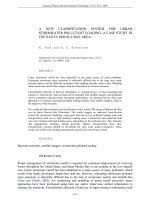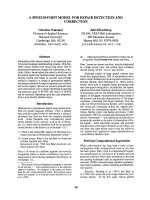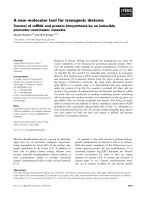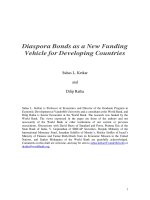A new bayesian classifier for skin detection
Bạn đang xem bản rút gọn của tài liệu. Xem và tải ngay bản đầy đủ của tài liệu tại đây (879.79 KB, 4 trang )
A New Bayesian Classifier for Skin Detection
Sajad Shirali-Shahreza
Computer Engineering Department
Sharif University of Technology
Tehran, IRAN
M. E. Mousavi
IT Department
Nasr Electronics Research Center
Tehran, IRAN
Abstract
Skin detection has different applications in
computer vision such as face detection, human
tracking and adult content filtering. One of the major
approaches in pixel based skin detection is using
Bayesian classifiers. Bayesian classifiers performance
is highly related to their training set.
In this paper, we introduce a new Bayesian
classifier skin detection method. The main contribution
of this paper is creating a huge database to create
color probability tables and new method for creating
skin pixels data set. Our database consists of about
80000 images containing more than 5 billions pixels.
Our tests shows that the performance of Bayesian
classifier trained on our data set is better than
Compaq data set which is one of the currently greatest
data sets.
1. Introduction
Computer vision is one of the active computer
science fields during the history of computer science.
It attracts researchers from early days of computer
history till now.
Automatic skin detection is one of primitive
computer task which is used in different applications
such as face detection [1] and adult content filtering
[2]. During past years, different skin detection methods
are proposed. These method can be divided into three
main categories [3]: explicitly defined skin regions,
non-parametric methods and parametric methods.
In explicitly defined skin detection methods, such
as [1] and [4], a series of rules such as “If Red>100
and Green<150, then pixel with color RGB is skin” are
created. If a skin pixel color matches one of these
rules, it will be marked as skin pixel. The main
advantage of these methods is their speed, while these
methods usually have poor performance.
The other two categories are machine learning
approaches. In these methods, the skin detection
problem is defined as a learning problem and the skin
detector is trained by a training set. The goal of these
methods is usually to calculate p(skin|RGB), which is
the probability that a pixel with color RGB be a skin
pixel. After learning the p(skin|RGB), these values are
used to create a skin probability map for image, such
as Figure 1(b). In skin probability map, the probability
that each pixel be a skin pixel is shown.
This probability map is used to create the skin map
which shows skin and non-skin pixels, such as Figure
1(c). The common and simple way to create skin map
from skin probability map is using a threshold. The
pixels with value greater than threshold are considered
as skin pixels and other pixels are considered as non-
skin pixels. The threshold can be constant [5] or
calculated adaptively for each image [3].
In non-parametric methods, such as [3] and one of
the methods proposed in [5], the p(skin|RGB) is
estimated base on training data set without considering
any model for probability model. The most common
way to do this is using Bayesian classifiers. More
details are explained in section 2, where we describe
our skin detection method which is a non-parametric
method. These methods usually have high true positive
and low false positive rates. The main drawback of
these methods is that storing p(skin|RGB) table (also
known as Look Up Table (LUT)) requires high
memory. A solution to this problem is using a smaller
space color, such as a color space with 32
3
colors
instead of 256
3
colors [5].
In parametric methods such as [2] and one of
methods in [5], it is assumed that the desired
probability function p(skin|RGB) has a special model.
Methods in this category usually use the Gaussian
Mixture Model (GMM) to approximate the
p(skin|RGB). In the model creation phase, the
parameters of the model, such as the mean and
variance of Gaussian models, are estimated from
training data set using algorithms such as EM [5].
The 3rd Intetnational Conference on Innovative Computing Information
and Control (ICICIC'08)
978-0-7695-3161-8/08 $25.00 © 2008 IEEE
For creating the skin probability map, the skin
probability p(skin|RGB) is calculated for each pixel
using the model created in learning phase. The main
advantage of these methods in comparison to non-
parametric methods is that they require a small space
for storing model. But they require more time to
compute the skin probability model. These methods
usually have higher true positive than non-parametric
methods but their false positive is also greater.
As we see, most of the skin detection methods
require a training data set to learn and the performance
of them depends on the size and quality of the data set.
Unfortunately there is no standard data set for this
purpose. The most common data set which is currently
available and is used is the data set created in [5] and is
freely available to university researchers.
This data set which is known as Compaq data set,
consists of more than 13000 images. The images are
divided into two sets, about 9000 images without any
skin region and about 4500 images which contains
skin regions. For each of the images with skin regions,
the skin regions are labeled by hand. We must note
that the skin pixel labeling is not down completely. It
means that they don’t try to label all of the skin pixels;
instead they try to label most important skin regions in
each image. This data set has more than 800 millions
pixels in images without skin regions and about 80
millions skin pixels in images with skin regions.
Although the Compaq data set is a good data set, it
has some problems. We will discuss some of them in
section 3. In this paper, we try to build a new huge
data set and avoid problems exist in Compaq data set.
We will describe our new skin detection algorithm
in section 2. In section 3, we discuss some of the
problems of Compaq data set and explain how we
create our data set to solve these problems. Our
experimental results are mentioned in section 4 and the
final section is the conclusion.
2. Our skin detection method
The skin detection method which we porpose in this
paper is a Bayesian skin detection method. In
probability based skin detection methods, we try to
calculate the p(skin|RGB) which is the probability that
the pixel is a skin pixel if the pixel color is RGB. In the
Bayesian skin detection methods, the p(skin|RGB) is
calculated using the Bayes theorem:
)(
)()|(
)|(
RGBp
skinpskinRGBp
RGBskinp =
(1)
To calculate the p(skin|RGB) using equation (1), we
need to calculate three probabilities: p(RGB|skin)
which is the probability that the color of a skin pixel is
RGB, p(skin) which is the probability that a pixel is a
skin pixel and p(RGB) which is the probability that the
color of a pixel is RGB.
After calculating the skin probability of each pixel,
usually a threshold is used to create the final skin map
and pixels with skin probability greater than the
threshold are set as skin pixels. So the accuracy is
independent of p(skin), because if someone else use
2*p(skin) instead of p(skin), then using 2*threshold
instead of threshold yields the same output.
In addition we must note that calculating p(skin) is
very difficult and we did not find any good method for
estimating it in the literature. A simple way to estimate
it is to number of skin pixels by total number of pixels
in the training data set. The problem of this estimation
is that in data sets, the ratio between total number of
images and images containing skin is not equal to ratio
of images containing skin to all images.
For the reasons we mentioned here, we ignored
estimating the p(skin) and the main work of our
method is to estimate p(RGB) and p(RGB|skin).
To estimate p(RGB|skin), we can create a data set
of sample skin pixels and then use the ratio of pixels
with color RGB to the number of pixels in data set as
an estimation of p(RGB|skin). This is the usual
approach used in Bayesian skin detection methods. For
example, we can use the skin pixels data set of
Compaq data set and use it to estimate p(RGB|skin),
like [5]. We use the same method to estimate
p(RGB|skin) in our method.
If we have a large enough data set of different
images, we can estimate the p(RGB) by the ratio of
pixels with that color to the total number of the pixels.
In the method proposed in [5] and other method which
uses the Compaq data set such as [6] and [3], the
p(RGB) is calculated using equation (2):
)()|(
)()|()(
skinpskinRGBp
skinpskinRGBpRGBp
¬¬
+=
(2)
In this equation, p(RGB|skin) is calculated based on
the skin pixels of the images in skin images data set
and the p(RGB|¬skin) is calculated based on the pixels
of the images in the non-skin images data set. This
approach has two problems. First it needs to know the
p(skin). Second, it is calculating p(RGB|skin) and
p(RGB|¬skin) on two different data sets and then
combines them, while the equation (2) is valid if all of
the probabilities are calculated on one data set. We try
to solve this problem by creating a skin pixel data set
as a part of total data set. We will describe the details
of our data set in next section. Our skin pixel data set
is part of our full data set. The full data set is used to
estimate p(RGB) by calculating the ratio of pixels with
color RGB to total number of pixels in data set.
The 3rd Intetnational Conference on Innovative Computing Information
and Control (ICICIC'08)
978-0-7695-3161-8/08 $25.00 © 2008 IEEE
A sample output of our skin detection method is
shown in Figure 1. Figure 1(a) shows the sample input
image to our method. Figure 1(b) shows the
probability map (the value p(skin|RGB) for each
pixeil). Figure 1(c) is the output skin map, which
shown the pixels with p(skin|RGB) greater than
defined threshold. Figure 1(d) is pixels of the input
image marked as skin pixels.
(a) Input image
(b) Skin probability
(c) Skin map
(d) Skin regions
Figure 1. Sample outputs of our method
3. Our data set
The main application of our skin detection
algorithm is adult content filtering. So we create a
huge data set of adult images. We run a crawler to
gather adult images from web. Among the outputs of
this crawler, we select about 80000 images. The image
size is usually about 800x600 or 1024x768. All of the
images are true color (24 bit) JPEG images. This data
set contains more than 5 billions of pixels which is 5
times greater than Compaq data set [5] which is one
the greatest data sets currently available.
We use a new method to create the skin pixels data
set. The method which is usually used for creating skin
pixels data set is to label all of the skin pixels of
images by hand and create the skin map. For example,
the Compaq data set is created using this method.
One of the problems of this approach is that this is a
difficult work and need a lot of time. In addition, using
this approach, usually the main skin regions of images
are marked and skin regions with certain features, such
as skin regions which are in the shadow of another
object are ignored. This problem is visible in the
Compaq data set and the skin detection methods which
use this data set such as [6].
To solve these problems, we propose a new
approach for creating skin pixel data sets. The main
object of our skin pixel data set is to have samples of
different types of skins. Usually it is more important to
have more samples of different types of skin instead of
having skins samples according to color probabilities.
We usually calculate the p(skin|RGB) to decide
whether the pixel is skin or not using a threshold. So
we don’t need the exact probability of p(skin|RGB),
instead we can have an estimation of it such as
q(skin|RGB) such that if p(skin|RGB)>threshold, then
q(skin|RGB)> threshold and vice. If we can calculate
such an approximation, then the results will be similar.
When we are defining q(skin|RGB), we can define
it so that we can calculate it more accurately. For
example, in equation (1), we need p(RGB|skin) and
p(RGB) to calculate p(skin|RGB). If p(RGB) is very
low and p(skin|RGB) is high, it means that the RGB
color is a rare color, but pixels with this color are
usually skin pixels. For such color, the probability that
such colors occur in the skin pixel data set in low. In
addition, they are more sensitive to labeling error, for
example they are only 100 such pixels in data set, if 30
of them is missed in an image, then our error on
labeling them is high, while the error resulted of
missing 1000 pixels among 100000 pixels of a
frequent color is less severe. Based on these
assumptions, we create our skin data set so that it
contains different types of skins. For example if there
is a large region of skin in an image, instead of
selecting all of it, we try to select different parts of it
with special features.
To create such samples, we design a program which
shows the image to the user and he must select
rectangular regions of image as skin parts. A sample
screenshot of our program is shown in Figure 2. The
black rectangles are skin regions selected by the user.
We randomly select 200 images among the entire
images in the data set. Then more than 2700 skin
regions are extracted from these images, similar to
regions in Figure 2. These skin regions contain more
than 3.6 millions of skin pixels. In selecting skin
regions, we try to select skin regions with different
illuminations and conditions, such as the skin of a limb
which is in the shadow of another limb.
Figure 2. A screenshot of our skin data set
creation program.
4. Experimental results
In this section we describe the experimental results
of our skin detection algorithm. To test the
performance of our method and comparing it with
The 3rd Intetnational Conference on Innovative Computing Information
and Control (ICICIC'08)
978-0-7695-3161-8/08 $25.00 © 2008 IEEE
Compaq data set, we collect 20 images containing
large skin regions from internet. We try to collect
image with different illumination conditions and
human races. Then the correct skin map of these
images is created by hand.
The skin probability map (similar to Figure 1(b)) is
calculated for each image using the desired method.
Then the performance of the method is calculated as a
Receiver Operation Characteristics (ROC) chart. In
order to create the ROC chart, we calculate the True
Positive and False Positive for each image. The True
Positive is the ratio of identified skin pixels to the total
number of the skin pixels. The False Positive is the
ratio of pixles incorrectly identified as skin pixels to
the total number of non-skin pixels. The different
values of True Positive and False Positive are obtained
by using different values for the threshold. For each
value used for threshold, the True Positive and False
Positive result for each image is calculated and the
mean of these results is used to draw the ROC chart.
The complete RGB true color space contains 256
3
colors. The probability p(skin|RGB) can be computed
for each color in this color space or for a smaller color
space. For example, we can consider the 64
3
color
space in which each of color components can have 64
different levels. Smaller color spaces have advantages
such as needing less memory to save probability tables
and ability to generalize the color model and reduce
over fitting. So it is usual to consider different color
space sizes in the literature, such as [5].
To evaluate the performance of method in different
color space sizes, we calculate the probabilites
p(skin|RGB) in 5 different color space sizes: 256
3
,
128
3
, 64
3
, 32
3
and 16
3
. The ROC of different color
space sizes is shown in Figure 3. As we can se, the
result is nearly similar in different color spaces.
We compare our method with Compaq data set. We
implement our method as described in section 2 in
Matlab. We also implement the method describe in [5]
to test Compaq data set. The ROC of two methods is
compared in Figure 4. As we see, our data set results
are better than Compaq data set.
0 0.1 0.2 0.3 0.4 0.5 0.6 0.7 0.8 0.9 1
0.2
0.3
0.4
0.5
0.6
0.7
0.8
0.9
1
False Positive
True Positive
Receiver Operating Characteristic (ROC)
256x256x256 Color Space
128128x128 Color Space
64x64x64 Color Space
32x32x32 Color Space
16x16x16 Color Space
Figure 3. ROC of different color space sizes.
0 0.1 0.2 0.3 0.4 0.5 0.6 0.7 0.8 0.9 1
0.5
0.6
0.7
0.8
0.9
1
False Positive
True Positive
Receiver Operating Characteristic (ROC)
Our Data Set
Compaq Data Set
Figure 4. Comparison of our data set and
Compaq data set.
5. Conclusion
Skin detection is an important process in computer
vision and used in different applications such as human
detection and tracking and adult content filtering. Most
of the skin detection methods need a large data set to
learn on it. In this paper, we present the data set we
prepared for skin detection. Our data set consists of
about 80000 images with more than 5 billions of pixels
and a subset of selected skin pixels with more than 3.6
millions skin pixels. We use new ideas in creating this
data set to solve some of problems of previous data
sets, such as well known Compaq data set [5]. Our
tests show that the Bayesian skin detection method
trained with our data set has better performance than
the one trained with Compaq data set. Because the
Compaq data set used in different skin detection
methods as the data set, those methods may be
improved by using our data set instead of Compaq data
set. This is one of the works which we are planned to
do in future.
6. References
[1] R.L. Hsu, M. Abdel-Mottaleb, and A.K. Jain, “Face
detection in color images,” IEEE Trans. on Pattern Analysis
and Machine Intelligence, vol. 24,. no. 5, pp. 696-706, 2002.
[2] W. Hu, O. Wu, Z. Chen, and Z. Fu, Maybank, S.,
“Recognition of Pornographic Web Pages by Classifying
Texts and Images,” IEEE Trans. on Pattern Analysis and
Machine Intelligence, vol. 29, no. 6, pp.1019-1034, 2007.
[3] M.J. Zhang, and W. Gao, “An adaptive skin color
detection algorithm with confusing backgrounds
elimination,” Proceedings of IEEE International Conference
on Image Processing (ICIP 2005), vol.2, pp. 390-393, 2005.
[4] M.M. Fleck, D.A. Forsyth, and C. Bregler, “Finding
naked people,” Proceedings of 4
th
European Conference on
Computer Vision (ECCV’96), pp. 593-602, April 1996.
[5] M.J. Jones and J.M. Regh, “Statistical Color Models with
Application to Skin Detection,” Cambridge Research
Laboratory Technical Report, CRL 98/11, 1998.
[6] W. Zeng, W. Gao, T. Zhang, and Y. Liu “Image guarder-
An intelligent detector for adult images,” Proceedings of
Asian Conference on Computer Vision, pp. 198-203, 2004.
The 3rd Intetnational Conference on Innovative Computing Information
and Control (ICICIC'08)
978-0-7695-3161-8/08 $25.00 © 2008 IEEE









